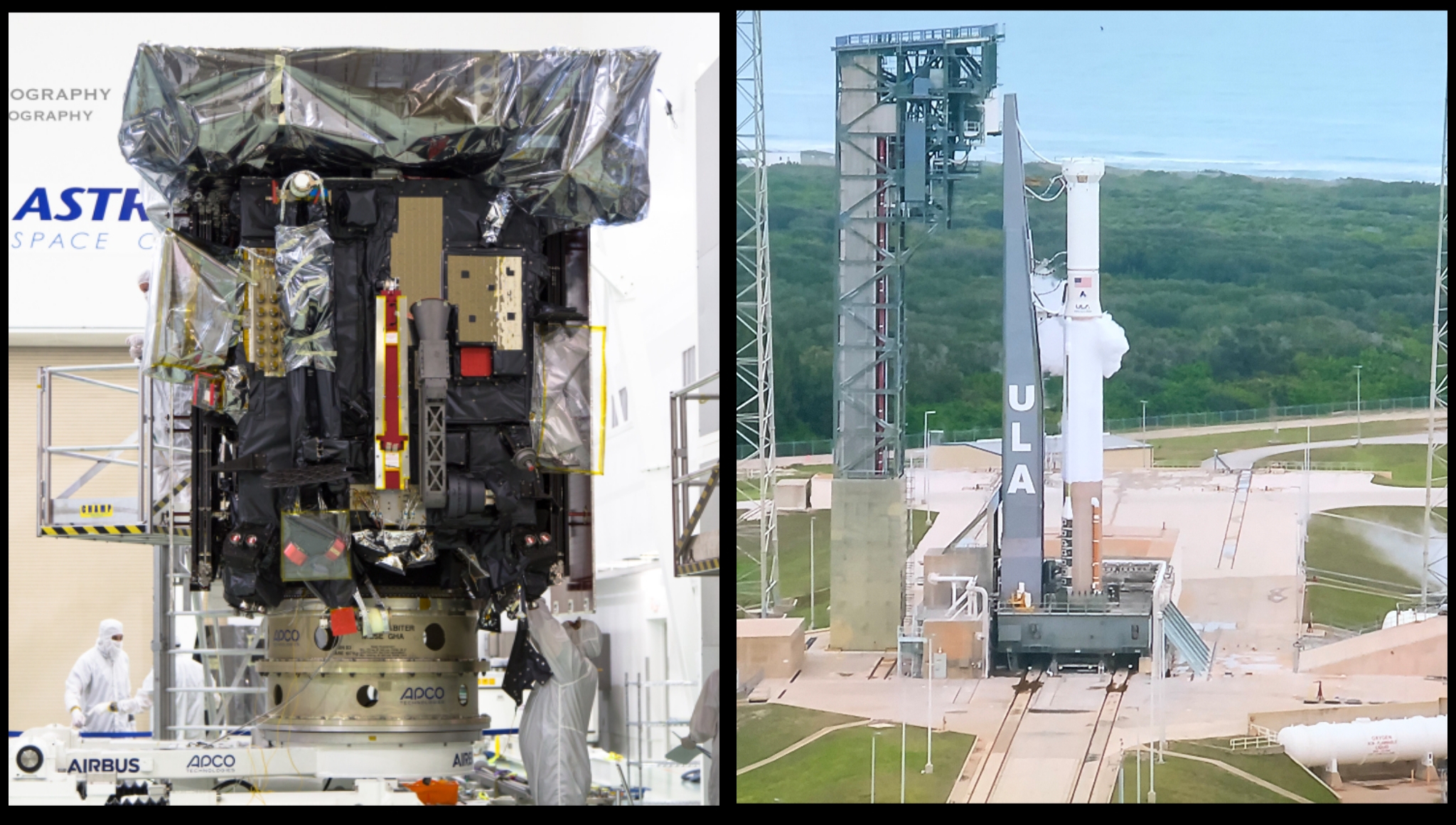
After a long and launchless six weeks, United Launch Alliance (ULA) has moved a step nearer to sending Europe’s Solar Orbiter on its multi-year voyage to study the Sun at closer range, in greater detail and from higher heliographic latitudes than ever before. The giant Atlas V booster assigned to the mission has wrapped up a smooth fueled (or “wet”) dress rehearsal (WDR) at Space Launch Complex (SLC)-41 at Cape Canaveral Air Force Station, Fla.
“NASA requires a WDR for missions with limited launch opportunities such as those to planets and the Sun,” says NASA. “WDRs allow us to test the rocket early in an effort to mitigate issues that could result in a missed opportunity for launch.”
The Wet Dress Rehearsal (WDR) was conducted primarily on account of the criticality of Solar Orbiter’s launch window. The spacecraft—which has been on the drawing boards at the European Space Agency (ESA) for more than two decades—will fly within 0.3 Astronomical Units (AU) of the Sun, a mere 26 million miles (42 million km), deep inside the orbit of the planet Mercury. Moreover, it will gradually adjust its trajectory to achieve heliographic latitudes as high as 34 degrees, allowing its fields and particles sensors and imaging instruments to directly observe the poles of the Sun as never before and examine fast-moving solar wind ions and coronal plasmas almost from their point of origin.
WATCH OUR VIDEO ABOVE FOR A RUNDOWN OF THE MISSION AND VISIT WITH THE SPACECRAFT AND MISSION LEADERSHIP IN FLORIDA!
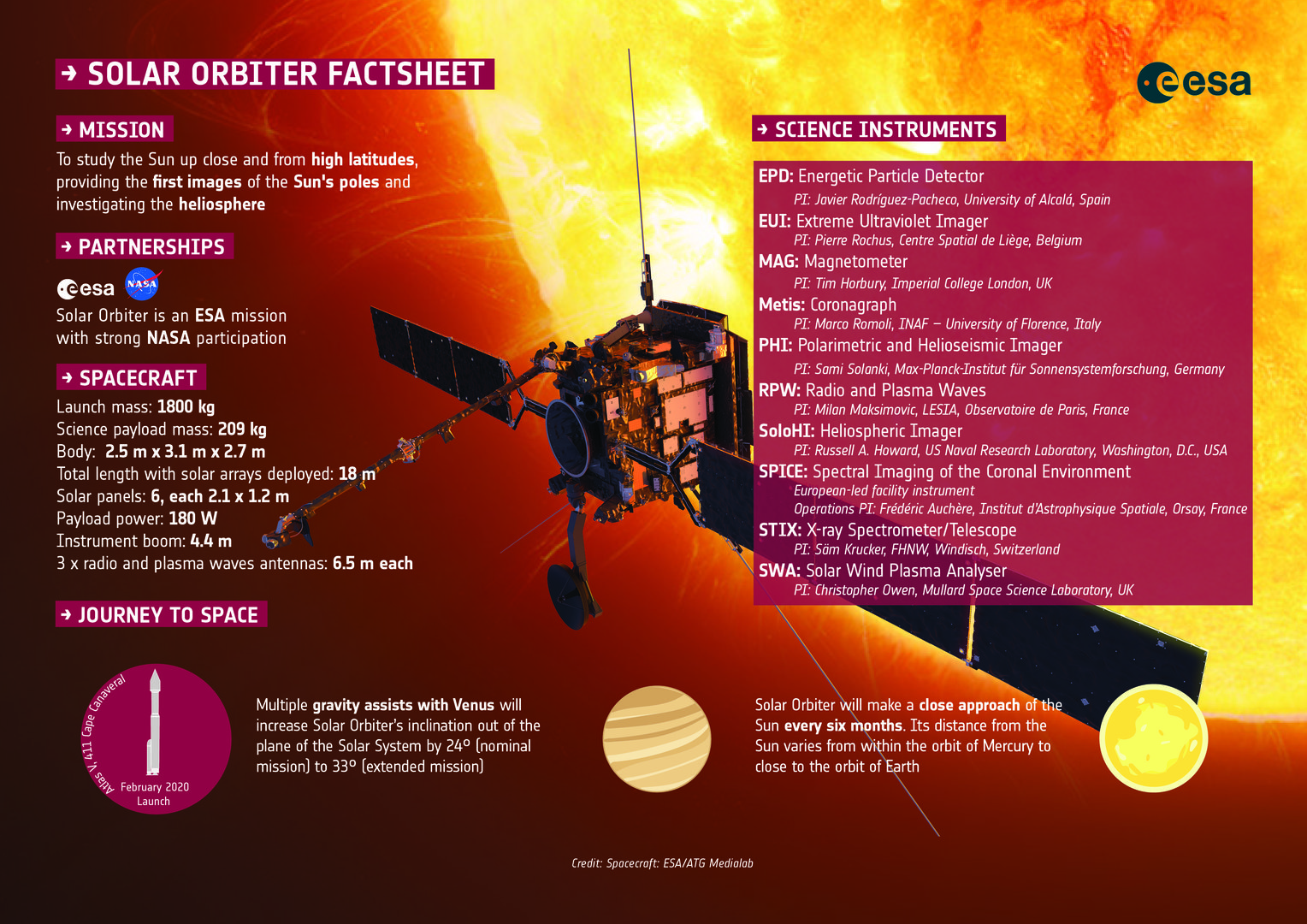
But to get so blisteringly close to the Sun, Solar Orbiter will undertake a hazardous journey that is expected to involve multiple flybys of Venus and one of Earth.
Following launch, the spacecraft will hurtle past Venus in December 2020 and again in August 2021, before returning to Earth and passing within 270 miles (430 km) of our home planet in November 2021. These three initial Gravity Assist Maneuvers (GAMs) are part of an intricate celestial “dance” that Solar Orbiter will take to reduce its orbital energy and increase its heliographic inclination to bring it deeper towards the Sun and into ever-higher latitudes. Departing Earth at the end of 2021, the “cruise” phase of its mission will end and the “science phase” will begin. Multiple Venus GAMs will be performed throughout the coming decade to crank Solar Orbiter’s latitude up as high as 34 degrees. And it is precisely because of the spacecraft’s date with Venus that a tight, three-week “launch window” from 5-23 February is needed.
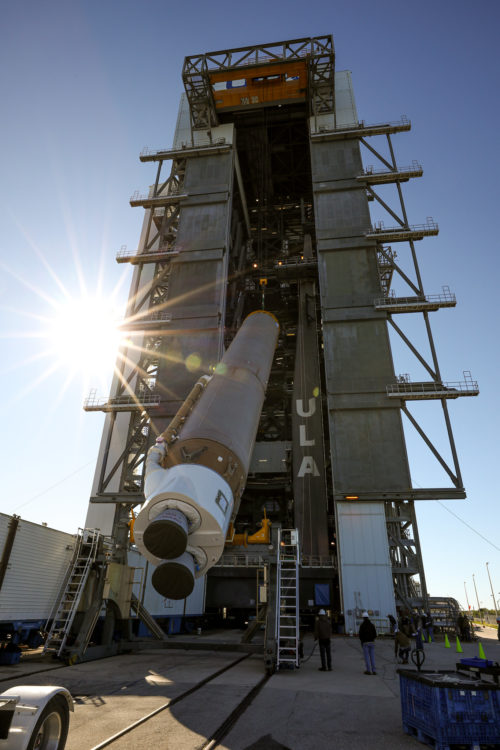
“WDRs are milestones meant to mitigate any issues before the actual launch day arrives,” ULA noted. “Typically, they are performed during the launch campaign for all planetary missions that have very short timeframes to launch. Missing that launch period would mean lengthy delays to wait for the next opportunity.”
Processing of the myriad components for the mission entered high gear in Florida last November, when Solar Orbiter itself arrived aboard an Antonov An-124 aircraft from Germany’s IABG engineering and test center, near Munich, and the components of the Atlas V rocket—its Common Core Booster (CCB) and single-engine Centaur upper stage—were delivered from ULA’s facility in Decatur, Ala. Early in January, the critical Launch Vehicle On Stand (LVOS) milestone was passed when the 107-foot-long (32-meter) CCB was erected on the Mobile Launch Platform (MLP) in the Vertical Integration Facility (VIF) at SLC-41. Shortly thereafter, a single solid-fueled booster was affixed to the CCB’s base and the 41-foot-long (12.6-meter) Centaur was hoisted atop the stack.

Bearing a strangely “incomplete” look—incomplete, of course, because there was no sign yet of Solar Orbiter and its payload shroud—the Atlas V was rolled from the VIF to the pad surface on Tuesday, 21 January, for the WDR. The CCB was loaded with its flight supply of 25,000 gallons (113,650 liters) of highly refined rocket-grade kerosene (RP-1), with the intention that this fuel would remain aboard through launch. Early Wednesday, preparations for the WDR got underway when the rocket stages were powered up, their guidance systems underwent tests and final preparations of ground systems. Supervised by ULA Launch Conductor Scott Barney and ULA Launch Director Lou Mangieri, all seemed ready for cryogenic tanking of the Centaur with liquid oxygen and hydrogen.
However, Wednesday was not to be ULA’s day. Shortly before cryogenic tanking was due to start, a cold air duct belonging to the environmental control system somehow became detached from the Centaur. Out of a sense of prudency, the Atlas V was rolled back to the VIF and the air duct replaced. Following a swift turnaround, the rocket was returned to the pad on Thursday for another attempt at the WDR on Friday. This time, and without incident, 66,000 gallons (300,000 liters) of liquid oxygen and hydrogen were pumped into the Centaur’s tanks, just as they will be on the real launch day. The mock “countdown” proceeded through each of its scheduled steps, including the final planned hold at T-4 minutes, before the test ended shortly prior to T-0.
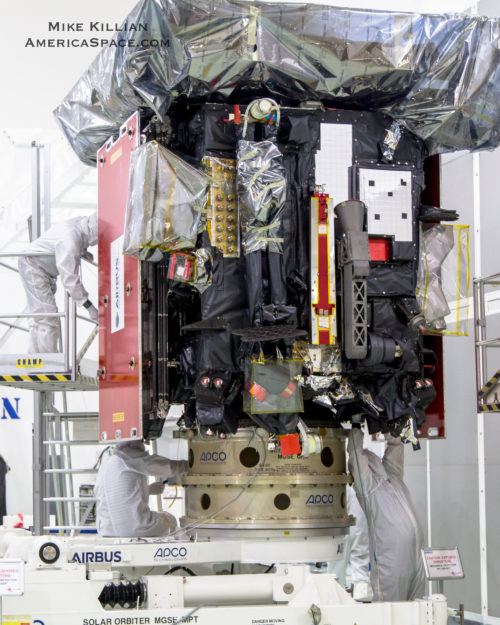
Following the WDR, the Atlas V was safed and its cryogenic tanks drained to wrap up the test. Yesterday (Saturday), the booster was returned to the VIF for the integration of its primary payload. Solar Orbiter was encapsulated in its two-piece payload fairing on 20 January and is expected to be hoisted atop the rocket early next week. With the payload in place, the Atlas V—which is flying for only the sixth time in its “411” configuration, with a 13-foot-diameter (4-meter) fairing, a single strap-on booster and a single-engine Centaur—will stand some 189 feet (57.6 meters) tall.
Ironically, the delay caused by the cold air duct replacement and the corresponding slippage of the WDR has directly impacted Solar Orbiter’s launch window. Rather than aiming for the opening day, 5 February, ULA is presently targeting the third day of the window, at 11:15 p.m. EST on Friday 7th.
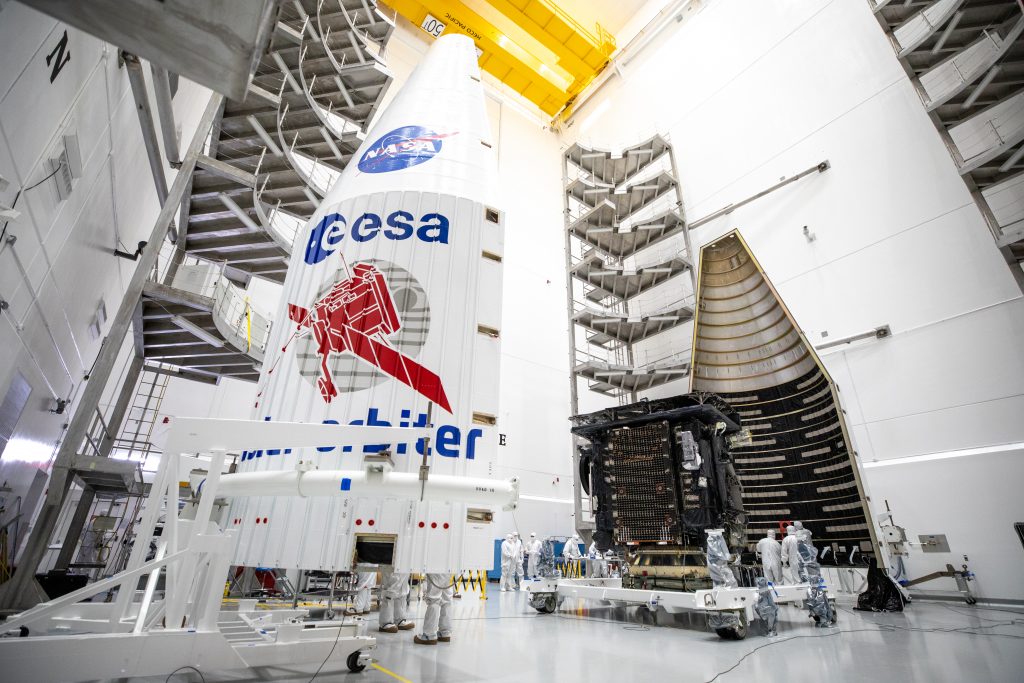
The spacecraft meanwhile was recently encapsulated for launch inside an aerodynamic bullet-like cover on Jan 20, which will protects it during ground operations, launch and ascent. Solar Orbiter’s instruments are sensitive to contamination, and the fairing has special provisions to make sure those instruments are not affected by particles or humidity.
Quelle: AS
----
Update: 29.01.2020
.
New Mission Will Take 1st Peek at Sun’s Poles
A new spacecraft is journeying to the Sun to snap the first pictures of the Sun’s north and south poles.
Solar Orbiter, a collaboration between the European Space Agency, or ESA, and NASA, will have its first opportunity to launch from Cape Canaveral on Feb. 7, 2020, at 11:15 p.m. EST. Launching on a United Launch Alliance Atlas V rocket, the spacecraft will use Venus’s and Earth’s gravity to swing itself out of the ecliptic plane — the swath of space, roughly aligned with the Sun’s equator, where all planets orbit. From there, Solar Orbiter's bird’s eye view will give it the first-ever look at the Sun's poles.
“Up until Solar Orbiter, all solar imaging instruments have been within the ecliptic plane or very close to it,” said Russell Howard, space scientist at the Naval Research Lab in Washington, D.C. and principal investigator for one of Solar Orbiter’s ten instruments. “Now, we’ll be able to look down on the Sun from above.”
“It will be terra incognita,” said Daniel Müller, ESA project scientist for the mission at the European Space Research and Technology Centre in the Netherlands. “This is really exploratory science.”
The Sun plays a central role in shaping space around us. Its massive magnetic field stretches far beyond Pluto, paving a superhighway for charged solar particles known as the solar wind. When bursts of solar wind hit Earth, they can spark space weather storms that interfere with our GPS and communications satellites — at their worst, they can even threaten astronauts.
To prepare for arriving solar storms, scientists monitor the Sun’s magnetic field. But their techniques work best with a straight-on view; the steeper the viewing angle, the noisier the data. The sidelong glimpse we get of the Sun’s poles from within the ecliptic plane leaves major gaps in the data.
“The poles are particularly important for us to be able to model more accurately,” said Holly Gilbert, NASA project scientist for the mission at NASA’s Goddard Space Flight Center in Greenbelt, Maryland. “For forecasting space weather events, we need a pretty accurate model of the global magnetic field of the Sun.”
The Sun’s poles may also explain centuries-old observations. In 1843, German astronomer Samuel Heinrich Schwabe discovered that the number of sunspots — dark blotches on the Sun’s surface marking strong magnetic fields — waxes and wanes in a repeating pattern. Today, we know it as the approximately-11-year solar cycle in which the Sun transitions between solar maximum, when sunspots proliferate and the Sun is active and turbulent, and solar minimum, when they're fewer and it’s calmer. “But we don’t understand why it’s 11 years, or why some solar maximums are stronger than others,” Gilbert said. Observing the changing magnetic fields of the poles could offer an answer.
The only prior spacecraft to fly over the Sun’s poles was also a joint ESA/NASA venture. Launched in 1990, the Ulysses spacecraft made three passes around our star before it was decommissioned in 2009. But Ulysses never got closer than Earth-distance to the Sun, and only carried what’s known as in situ instruments — like the sense of touch, they measure the space environment immediately around the spacecraft. Solar Orbiter, on the other hand, will pass inside the orbit of Mercury carrying four in situ instruments and six remote-sensing imagers, which see the Sun from afar. “We are going to be able to map what we ‘touch’ with the in situ instruments and what we ‘see’ with remote sensing,” said Teresa Nieves-Chinchilla, NASA deputy project scientist for the mission.
After years of technology development, it will be the closest any Sun-facing cameras have ever gotten to the Sun. “You can’t really get much closer than Solar Orbiter is going and still look at the Sun,” Müller said.
Over the mission’s seven year lifetime, Solar Orbiter will reach an inclination of 24 degrees above the Sun’s equator, increasing to 33 degrees with an additional three years of extended mission operations. At closest approach the spacecraft will pass within 26 million miles of the Sun.
To beat the heat, Solar Orbiter has a custom-designed titanium heat shield with a calcium phosphate coating that withstands temperatures over 900 degrees Fahrenheit — thirteen times the solar heating faced by spacecraft in Earth orbit. Five of the remote-sensing instruments look at the Sun through peepholes in that heat shield; one observes the solar wind out to the side.
Solar Orbiter will be NASA’s second major mission to the inner solar system in recent years, following on August 2018’s launch of Parker Solar Probe. Parker has completed four close solar passes and will fly within four million miles of the Sun at closest approach.
The two spacecraft will work together: As Parker samples solar particles up close, Solar Orbiter will capture imagery from farther away, contextualizing the observations. The two spacecraft will also occasionally align to measure the same magnetic field lines or streams of solar wind at different times.
“We are learning a lot with Parker, and adding Solar Orbiter to the equation will only bring even more knowledge,” said Nieves-Chinchilla.
Solar Orbiter is an international cooperative mission between the European Space Agency and NASA. ESA's European Space Research and Technology Centre (ESTEC) in The Netherlands manages the development effort. The European Space Operations Center (ESOC) in Germany will operate Solar Orbiter after launch. Solar Orbiter was built by Airbus Defense and Space, and contains 10 instruments: nine provided by ESA member states and ESA. NASA provided one instrument suite, SoloHI and provided detectors and hardware for three other instruments.
Quelle. NASA
----
Update: 2.02.2020
.
Solar Orbiter completes preparation for launch

Europe's grand mission to understand the detailed workings of the Sun is all but ready for launch.
Solar Obiter has been enclosed in its protective cover and mounted atop the rocket that will hurl the satellite towards our star next weekend.
SolO, for short, is a €1.5bn (£1.3bn) project of the European Space Agency (Esa) with a big input from the US.
Its goal is to help scientists better understand what drives the Sun's dynamic behaviour.
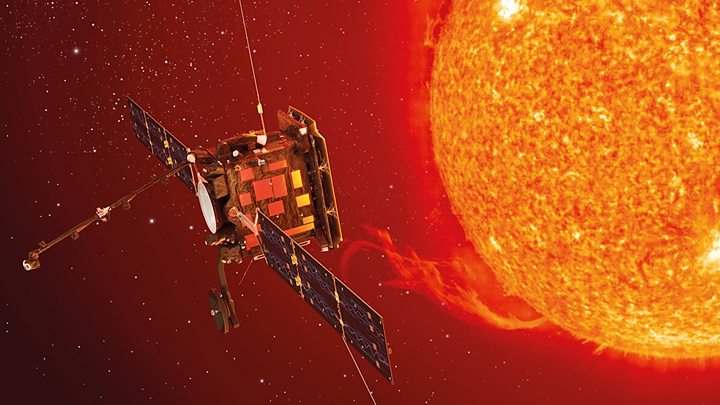
The spacecraft travelled out to Florida's Cape Canaveral launch complex at the end of last year to begin a series of final checks.
But with those tests now complete and with Solo filled with a quarter tonne of fuel, engineers have cleared the probe for flight.
This resulted in Solo first being closed inside the 4m-wide, clamshell-shaped fairing that will protect the satellite as it ascends through the atmosphere to space.
Then, on Friday, the spacecraft was driven out to meet its United Launch Alliance Atlas rocket.
SolO was hoisted into position above the vehicle's main core and Centaur upper-stages.
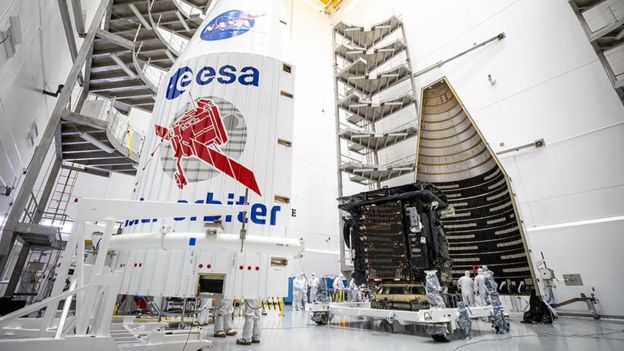 Image copyrightNASA
Image copyrightNASA
In the coming week, the Atlas will be rolled on to the pad at Cape Canaveral Air Force Station Space Launch Complex 41.
Lift-off is currently scheduled for 23:03 local time on Sunday 9 February (04:03 GMT on Monday 10 February).
Ian Walters is the programme manager for Solar Orbiter at Airbus, the pan-European aerospace manufacturer that has assembled this exquisite science satellite over the past decade.
"It's an astonishing spacecraft," he told BBC News.
"It's got 10 instruments to study the Sun, but in reality each instrument is a consortium of different instrument packages. That gives Solar Orbiter tremendous capability but these different packages all have their own priorities.
"Some want no dust contamination, some want a very clean magnetic environment, some want to be cold, some want to be hot. All these conflicting design drivers we've been able to satisfy and deliver everything the scientists wanted."
The Atlas rocket will send SolO on a path towards the inner Solar System. The spacecraft will then use gravitational flybys of Venus and Earth to get itself inside the orbit of Planet Mercury, just 43 million km from the Sun.
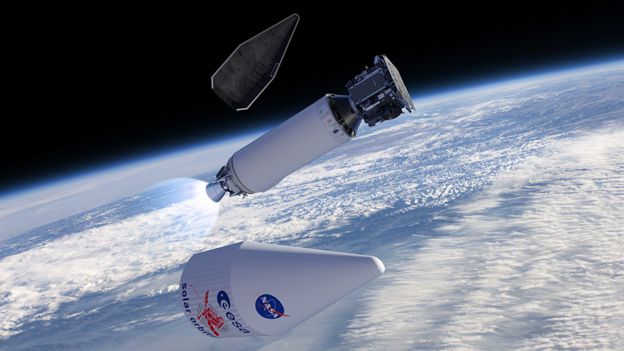 Image copyrightESA
Image copyrightESA
The probe will train its telescopes on the surface of our star, resolving details as small as 70km across. The pictures should be stunning - but they are just half of SolO's science. The spacecraft also carries instruments to sense the constant flow from the Sun of charged particles and their entrained magnetic fields.
It is this combination of the remote sensing and in-situ measurements that should yield fresh insights on our star's sometimes dramatic activity.
"We will probably unravel better the mechanism that is producing the magnetic field of the Sun and is also producing these huge explosions that are a worry for all kinds of infrastructure in space," said Günther Hasinger, Esa's director of science.
"The astronauts, for instance - if they really want to go to the Moon and Mars, they have to be wary of 'solar weather'; but also the satellites and power stations which can be affected."
From a British perspective, Solar Orbiter is arguably the most important space science mission in a generation.
The UK arm of Airbus assembled the probe. "More important in my opinion, we lead two instruments and have major roles on two others - out of the 10. So, it is a crucial validation of our world-leading role in solar physics science," said Chris Lee, the head of science programmes at the UK Space Agency.
Financially, Britain has investment well in excess of €200m in Solar Orbiter.
Quelle: BBC
----
Update: 5.02.2020
.
NASA, Europe get ready to launch Solar Orbiter mission on ULA's Atlas V rocket
The solar probe launching Sunday from the Space Coast and headed on a nearly 65 million mile journey to the sun isn't looking for life.
But the answers it provides might bring us one step closer.
"What makes a planet habitable is really understanding the star that it lies next to," said Nicola Fox, director of NASA's Heliophysics Division during a media teleconference Jan. 27.
The Solar Orbiter, which will provide a never-before-seen global view of our sun, is the latest effort in what helophysicists are calling a golden age of solar physics.
"It is the key to what really makes that new location habitable," Fox said.
Scientists have known for decades the sun creates and controls the space environment enveloping our solar system. But they don't know how the sun does that.
That's why throughout the years, they have sent out probes to learn more about this special star and on Sunday, one more will be sent out to space.
Called Solar Orbiter, this international cooperative mission between the European Space Agency and NASA will help tackle questions scientists have been yearning for years to answer.
Launching atop United Launch Alliance's Atlas V rocket no earlier than 11:03 p.m. Sunday from Cape Canaveral Air Force Station Launch Complex 41, the 10-foot-long spacecraft aims to make up-close observations of the sun through telescopes and capture the first photos of the star's poles.
"What we want to do with Solar Orbiter is to understand how our star creates and controls the constantly changing space environment throughout the solar system," said Yannis Zouganelis, ESA deputy project scientist for Solar Orbiter at the European Space Astronomy Centre in Madrid, Spain during the teleconference.
"So mainly how the sun is influencing interplanetary space, including our Earth, and what are the main mechanisms that are responsible for the solar activity," he said.
Through Solar Orbiter, scientists hope to answer key questions in four areas:
• Solar wind (the constant flow of charged particles emitted from the sun that permeate the entire solar system): What drives it, where does it come from, how is it accelerated and where does the corona magnetic field originate?
• Coronal mass ejection (plasma or charged particles released from the solar corona): How are they created, how are they accelerated and how do they evolve as they travel throughout interplanetary space?
• Solar reactions that produce energetic particles: How do the solar reactions produce them and how does the energetic particle radiation feed the whole heliosphere (the region of space in which the sun's solar wind has a significant influence)?
• Solar activity: How does it work and how does it drive the connections between the sun and the heliosphere?
The Solar Orbiter will work with NASA's Parker Solar Probe, which launched in August 2018, to provide the most comprehensive look of our star through up-close observations and imagery, according to NASA.
The $1.5 billion mission will travel as close as 26 million miles from the sun (the Parker Solar Probe will come within 4 million miles for comparison), where it will use 10 different instruments to measure magnetic fields, waves, energetic particles and plasma escaping the sun while they are still in a pristine state.
Scientists now have a 16-day launch window opportunity, having been delayed from its original launch date on Feb. 5, to send Solar Orbiter on its way. If the mission is delayed after this window, however, the next possible opportunity would not be until October.
Quelle: Florida Today
----
Update: 8.02.2020
.
Weather is good for ULA Atlas V launch with NASA, European Space Agency Solar Orbiter probe
The days are inching nearer for NASA and the European Space Agency to send its Solar Orbiter spacecraft on a nearly 65 million mile journey to learn more about our sun.
Launching atop United Launch Alliance's Atlas V rocket no earlier than 11:03 p.m. Sunday from Cape Canaveral Air Force Station Launch Complex 41, weather is currently forecasted as 80% "go," as calculated by the U.S. Air Force.
"The primary concern for launch is the Cumulus Cloud Rule (meaning an increase in clouds and rain showers during the launch window)," according to the 45th Weather Squadron.
If the mission is delayed to another day, weather drops slightly to 70% "go" for a Monday launch.
Teams have two hours to launch the spacecraft Sunday, beginning at 11:03 p.m. and if everything goes smoothly, this will also be ULA's first launch of 2020.
The Solar Orbiter joins other solar probes, including NASA's Parker Solar Probe which launched August 2018, to understand how the sun affects the space environment in our solar system.
Traveling as close as 26 million miles from the sun, Solar Orbiter will use its 10 instruments to measure magnetic fields, waves, energetic particles and plasma escaping the sun while it is still in a pristine state.
Through up-close observations through telescopes, Solar Orbiter will also capture the first photos of the sun's poles. Working with Parker, these two probes will provide a never-before-seen global view of the sun, according to NASA.
Quelle: Florida Today
+++
Download related materials from Feb. 7's pre-launch science briefing at NASA's Kennedy Space Center.
It will be a dark winter’s night when Solar Orbiter launches from Florida on its journey to the source of all light on Earth, the Sun.
The mission, a collaboration between ESA (the European Space Agency) and NASA, is scheduled to begin Feb. 9, 2020, during a two-hour launch window that opens at 11:03 p.m. EST. The two-ton spacecraft launches from Cape Canaveral on a United Launch Alliance Atlas V rocket.
Seeking a view of the Sun’s north and south poles, Solar Orbiter will journey out of the ecliptic plane — the belt of space, roughly aligned with the Sun’s equator, through which the planets orbit. Slinging past Earth and repeatedly around Venus, the spacecraft will draw near the Sun and climb higher above the ecliptic until it has a bird’s eye view of the poles.
There, Solar Orbiter will try to answer basic questions about the Sun, whose every burp and breeze holds sway over the solar system. What drives the solar wind, the gust of charged particles constantly blowing from the Sun? Or, what churning deep inside the Sun generates its magnetic field? How does the Sun’s magnetic field shape the heliosphere, the vast bubble of space dominated by our star?
“These questions are not new,” said Yannis Zouganelis, ESA deputy project scientist at the European Space Astronomy Centre in Madrid. “We still don’t understand fundamental things about our star.”
In solving these mysteries, scientists seek to better understand how the Sun shapes space weather, the conditions in space that can impact astronauts, satellites, and everyday technology like radio and GPS.
Over the next seven years, Solar Orbiter will travel as close as 26 million miles to the Sun — closing about two-thirds the distance from Earth to the star. It will climb 24 degrees above the ecliptic for a vista of the poles and the far side of the Sun.
“We don’t know what we’re going to see,” said Teresa Nieves-Chinchilla, NASA deputy project scientist at NASA’s Goddard Space Flight Center in Greenbelt, Maryland. “Our view of the Sun is going to change a lot in the next few years.”
Enabling its scorching voyage is a heat shield sporting a black coating of calcium phosphate, a charcoal-like powder similar to pigments used in cave paintings tens of thousands of years ago. All but one of the spacecraft’s telescopes peer through holes in the heat shield. At closest approach, the front of the shield will near 1,000 degrees Fahrenheit, while the instruments tucked behind it will remain at a comfortable range — for them — between minus 4 F and 122 F above zero.
Because Earth orbits through the ecliptic plane, we don’t get a good view of the poles from afar. It’s a bit like trying to glimpse Mount Everest’s summit from the base of the mountain. Crucially, the poles are still missing from space weather models that scientists use to forecast solar activity.
Like Earth’s own North and South poles, the Sun’s poles are extreme regions quite different from the rest of the Sun. They’re covered in coronal holes, cooler stretches where the fast solar wind comes gushing from. There, scientists hope to find the footprints of knotted magnetic fields underlying solar activity. Many think the poles hold the first clues to the intensity of the next solar cycle, which comes roughly every 11 years, as the Sun swings from seasons of high to low activity.
With a powerful array of 10 instruments, Solar Orbiter is like a lab in orbit, designed to study the Sun and its outbursts in great detail.
“What makes Solar Orbiter unique is this combination of really high-resolution imagers and in situ instruments, getting perspectives we haven’t seen yet,” said Daniel Müller, ESA project scientist at the European Space Research and Technology Centre in the Netherlands.
Ideally, Müller said, Solar Orbiter will image where solar wind bubbles on the surface and study the properties of that gust of wind as it flows from the Sun and passes the spacecraft. For the first time, scientists will be able to map what comes out of the Sun to precisely where it came from.
The instruments are also designed to work in concert, enhancing their observing power, said ESA payload manager Anne Pacros. When something fleeting like an X-ray solar flare blazes on the surface, the spacecraft’s X-ray instrument will see, and alert the others to pay attention.
“They enter burst mode, where they take more data, faster, responding to solar activity in real time,” Pacros said. “This promises much more science with what we have on board.”
Solar Orbiter’s destination is largely uncharted, a little-explored region of the heliosphere. Its unique vantage point is key to a complete understanding of the Sun’s activity and cycles. By offering regular views of the far side of the Sun, and the first images of the solar poles, Solar Orbiter joins a team of NASA heliophysics missions seeking to understand how the Sun affects the space around Earth and all the planets.
“We have all these amazing missions located in exactly the right place we want to study,” said Nicola Fox, director of the Heliophysics Division at NASA Headquarters in Washington. “They’re in places that allow us to do big system science, more science than you could do with just one mission alone.”
In particular, Solar Orbiter will work closely with NASA’s Parker Solar Probe. The two are natural teammates. Together, they’ll provide a never-before-seen global view of our star.
The duo makes new multi-point measurements possible; these are useful for tracking how flows from the Sun develop and change. As Parker Solar Probe samples hot solar gases up close, Solar Orbiter can tell us more about the very space Parker flies through. Or, they might simultaneously image the same structure in the corona, the solar atmosphere, sharing views from the poles and equator. At various points, the two missions will make coordinated observations.
“Parker Solar Probe and Solar Orbiter, in orbit together, is a big milestone,” Nieves-Chinchilla said. “This is something heliophysicists have been waiting on for decades. In the next decade, together, the two will be sure to change the field.”
After launch, the operations team will conduct three months of commissioning to ensure the instruments are operating properly. Once this check-out period is complete, the in situ instruments will turn on; the remote-sensing instruments will remain in cruising mode until Solar Orbiter’s first solar approach in November 2021.
Solar Orbiter is an international cooperative mission between ESA and NASA. ESA's European Space Research and Technology Centre (ESTEC) in the Netherlands manages the development effort. The European Space Operations Center (ESOC) in Germany will operate Solar Orbiter after launch. Solar Orbiter was built by Airbus Defence and Space, and contains 10 instruments: nine provided by ESA member states and ESA. NASA provided one instrument, SoloHI and an additional sensor, the Heavy Ion Sensor, which is part of the Solar Wind Analyzer (SWA) instrument suite.
Quelle: NASA
----
Update: 10.02.2020
.













































 Astronomie - Startvorbereitung für AtlasV 411 mit ESA Solar Orbiter Proba-3 Mission -Update-2
Astronomie - Startvorbereitung für AtlasV 411 mit ESA Solar Orbiter Proba-3 Mission -Update-2





